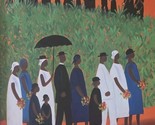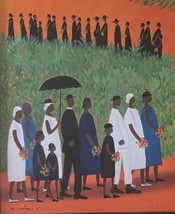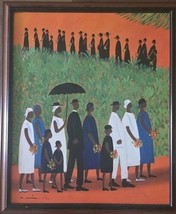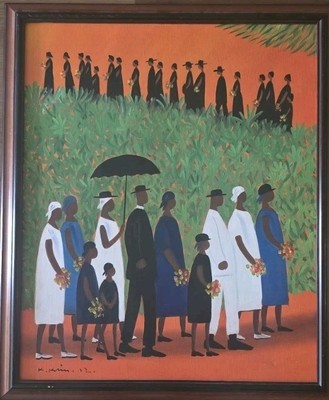Rendered at 13:29:08 09/05/25
Free Shipping
196 recent views
Signed The Funeral Procession Ellis Wilson Painting Rendition Black Folk Art
Shipping options
Estimated to arrive by Wed, Sep 17th.
Details
FREE via UPS Ground (1 to 5 business days) to United States
Offer policy
OBO - Seller accepts offers on this item.
Details
Return policy
Purchase protection
Payment options
PayPal accepted
PayPal Credit accepted
Venmo accepted
PayPal, MasterCard, Visa, Discover, and American Express accepted
Maestro accepted
Amazon Pay accepted
Nuvei accepted
Shipping options
Estimated to arrive by Wed, Sep 17th.
Details
FREE via UPS Ground (1 to 5 business days) to United States
Offer policy
OBO - Seller accepts offers on this item.
Details
Return policy
Purchase protection
Payment options
PayPal accepted
PayPal Credit accepted
Venmo accepted
PayPal, MasterCard, Visa, Discover, and American Express accepted
Maestro accepted
Amazon Pay accepted
Nuvei accepted
Item traits
| Category: | |
|---|---|
| Quantity Available: |
Only one in stock, order soon |
| Condition: |
Used |
| Subject: |
Figures |
| Style: |
Contemporary Art |
| Color: |
Black |
| Size: |
Medium (up to 36in.) |
| Type: |
Painting |
| Original/Licensed Reproduction: |
Original |
| Signed: |
Yes |
| Item Height: |
24 |
| Title: |
Funeral Procession |
| Theme: | |
| Material: |
Canvas |
| Framing: |
Framed |
| Country/Region of Manufacture: |
United States |
Listing details
| Seller policies: | |
|---|---|
| Shipping discount: |
Seller pays shipping for this item. |
| Price discount: |
20% off w/ $1,000.00 spent |
| Posted for sale: |
More than a week ago |
| Item number: |
1750055570 |
Item description
The product is an rendition of a original painting by Ellis Wilson titled "The Funeral Procession," which falls under the genre of Black Folk Art. This medium-sized canvas painting features a contemporary style with a theme that revolves around events and festivals, specifically focusing on African American culture and domestic family life. The painting is in excellent condition, an acrylic painting on canvas depicts a funeral procession, showcasing figures and landscapes with a touch of floral elements. Signed by the artist, this framed artwork is a unique and culturally significant piece originating from the United
States.
Funeral Procession is the name of a painting by Ellis Wilson, which went from obscurity to notoriety in 1986, when it was featured heavily in the episode "The Auction" of the TV series The Cosby Show's second season. In the episode, Clair Huxtable states that Wilson was her great-uncle, and that her grandmother had owned the painting until she had to sell it in order to pay her medical bills. After discovering that it is being sold at auction, she places an $11,000 winning bid and her husband Cliff hangs it over the fireplace in the family living room, where it stays for the remainder of the eight-season series.
About the artist:
Ellis Wilson is best known for paintings that presented African American subjects with objectivity and dignity, devoid of idealization, caricature, or mythical attributes. A colorist with a preference for simplified modern compositions, Wilson wrote in a 1939 Guggenheim fellowship application that he was ?most interested in painting the Negro. Unfortunately, this type of painting hasn?t a large following at present. I am desirous of both making a name for myself in the Art World and to create paintings which will be a credit to my Race and my time.?
Wilson attributed his artistic inclinations to his father, an amateur painter who worked in what Wilson described as a primitive style. Growing up in Mayfield, Kentucky, young Ellis held a variety of odd jobs and constantly looked for creative outlets in the midst of the mundane. While employed as the janitor for a local dress shop, for example, Wilson drew pictures on the store window using cleaning soap, an exercise that was subsequently encouraged by the shop owner as a promotional ploy. In 1916, Wilson enrolled at Frankfurt?s Kentucky Normal and Industrial Institute for Colored Persons (now Kentucky State University). Frustrated that his studies were limited to either agriculture or education, he left after two years, embarking on a decade-long residency in Chicago. There, Wilson earned a degree from the Art Institute of Chicago in 1923 and participated in the Chicago Art League. The typically shy and reserved youth blossomed during these years. It was a time of inspiration for Wilson, who was interacting with other creative African Americans.
After briefly working as a commercial artist in Chicago, Wilson moved to New York. There, he became involved with the Harmon Foundation, exhibiting his work in the 1933 and 1935 annuals. From 1935 to 1940, Wilson found steady employment, as did so many artists of the day, with the Works Progress Administration?s Federal Art Project. Once again, Wilson?s relationships with other African American artists, such as Joseph Delaney, proved fruitful. Undoubtedly inspired by the early work of Abstract Expressionist painters also working for the WPA, Wilson?s academic style gradually became more abstract. A series of works of airplane factory laborers created during these years won him a Guggenheim Fellowship in 1944 and, again, in 1945. Wilson used these funds to travel throughout the South and capture the ?poise and simple dignity? of African Americans at work. He painted men making turpentine in Georgia, laborers hewing lumber in South Carolina, and field hands harvesting tobacco in Kentucky.
With prize monies from the 1952 National Terry Art Exhibition, Wilson took the first of several trips to Haiti. Invigorated by African-Caribbean culture, Wilson abandoned his representational style in favor of an almost fauvist abstraction executed in heightened color. His subjects appear as Black silhouetted forms devoid of facial features and clothed in basic geometric shapes absent of folds and other details, as evidenced by African Princesses.
Although Wilson continued to paint until his death in 1977, his work fell into relative obscurity in the 1950s. Interest was renewed, however, in the 1980s when his painting Funeral Procession (circa 1950) was used on the set of the popular television series, The Cosby Show. His paintings have since been featured in numerous national exhibitions and, in 2000, Kentucky Educational Television produced a documentary titled Ellis Wilson: So Much to Paint. Today, Wilson?s work can be found in the collections of the Smithsonian American Art Museum, the North Carolina Museum of Art, and the Amistad Research Center at Tulane University, among others.
Added to your wish list!

- Signed The Funeral Procession Ellis Wilson Painting Rendition Black Folk Art
- 1 in stock
- Price negotiable
- Handling time 5 days. Estimated delivery: Wed, Sep 17th
Get an item reminder
We'll email you a link to your item now and follow up with a single reminder (if you'd like one). That's it! No spam, no hassle.
Already have an account?
Log in and add this item to your wish list.














